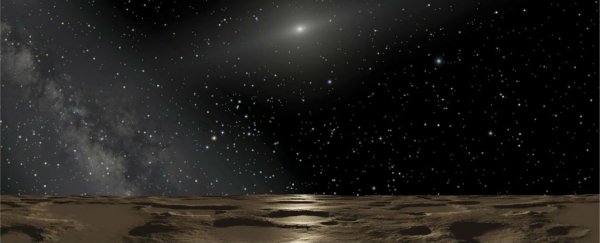Scientists have identified a new dwarf planet in our Solar System, and it's lurking way out in the edges, some 13.6 billion km (8.5 billion miles) from the Sun.
The Iowa-sized object - for now known as 2014 UZ224 - takes 1,100 years to complete a single orbit of the Sun, and could soon join the ranks of the five established dwarf planets in the Solar System: Ceres, Eris, Haumea, Makemake, and most famous of all, Pluto.
While only five dwarf planets have been officially recognised in the Solar System, it's thought that there could be at least 100 more lurking in the Kuiper Belt - a region beyond the orbit of Neptune that's thought to be teeming with comets, asteroids, and small planetary bodies.
Discovered by a team of undergraduate students led by physicist David Gerdes from the University of Michigan, 2014 UZ224 was pinpointed in an enormous map of galaxies created by a project called the Dark Energy Survey (DES).
To spot a Solar System object in a massive map of several distant galaxies, you basically just have to look for something that's moving.
"Objects in the Solar System, when you observe them at one instant and then a little while later, they appear to be in a different place in the sky," Gerdes told Joe Palca at NPR.
The team then used specialised computer software to connect the dots and confirm that what they were looking at was a single object - something that took years to figure out.
"We often just have a single observation of the thing, on one night," said Gerdes. "And then two weeks later one observation, and then five nights later another observation, and four months later another observation. So the connecting-the-dots problem is much more challenging."
The discovery has now been confirmed by the International Astronomical Union, but whether or not it will decide to let 2014 UZ224 join the ranks of the five established dwarf planets in our Solar System is another matter.
Both 2014 UZ224, and the other new dwarf planet was discovered in our Solar System back in July - called 2015 RR245 - technically pass the criteria for dwarf planets, which describes an object that resembles a planet, but isn't a planet.
The most important distinction for a dwarf planet is that it's large enough to have become round due to its own gravitational attraction.
As notorious "Pluto killer", Mike Brown - the California Institute of Technology astronomer who successfully campaigned for Pluto to be downgraded to a dwarf planet in 2006 - explains, we can pretty much assume that anything larger than 400 km in diameter in the Kuiper belt is round, and therefore could qualify as a dwarf planet.
2014 UZ224 is estimated to have a diameter of around 530 km (329 miles).
But why do astronomers care about round? Brown says, the ability for an object to transition from an irregular shape to a round one makes it more likely to have properties that astronomers will want to study.
"Th[e] transition from irregularly shaped to round objects is important in the Solar System, and, in some ways, marks the transition from an object without and with interesting geological and planetary processes occurring," he explains.
The tricky part is that the classification for dwarf planets is fairly new, and can be a little subjective. Brown has his own 'benchmarks' for what makes something more dwarf planet-like than others, and it'll be up to the International Astronomical Union to decide if 2015 RR245 and 2014 UZ224 make the official cut.
"It's also possible some astronomers might argue that the object Gerdes found is too small to be considered a dwarf planet, but for now, he says the term applies," NPR reports.
That said, anything to make poor old Pluto a little less lonely out there is a win in our books.

